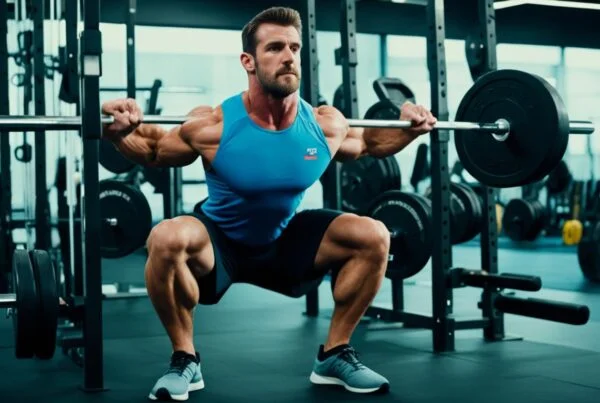When it comes to building strong and defined quadriceps, finding the right workout frequency and volume is key. By understanding the recommended guidelines and ranges for training volume, you can optimize your quad growth without overtraining. Let’s explore the ideal quad workout frequency and volume based on factual data.
Key Takeaways:
- Finding the optimal quad workout frequency and volume is essential for achieving optimal growth without overtraining.
- Training volumes play a crucial role in muscle growth. Understanding landmarks such as MV, MEV, MAV, MRV, MAV*P, and MRV*P can guide your quad workout frequency and volume.
- Recommended training volume ranges for serious and intermediate lifters vary from maintenance volume to maximum adaptive volume and maximum recoverable volume.
- Consider the right frequency and intensity for quad workouts based on your experience and recovery ability.
- Effective quad exercises such as the Feet Forward Smith Squat, Front Squat, and Leg Press target different portions of the quads and can be adjusted based on individual preferences and goals.
Understanding Quad Workout Frequency and Volume for Training
In order to optimize your quad growth, it is important to understand the role of training volumes in muscle development. By familiarizing yourself with key definitions and landmarks related to training volumes, you can tailor your quad workout frequency and volume to achieve maximum results.
Let’s explore these important terms:
- Maintenance Volume (MV): This refers to the amount of training volume required to maintain your existing muscle mass.
- Minimum Effective Volume (MEV): MEV is the minimum amount of training volume needed to see measurable improvements in your quad muscle mass. It represents the threshold at which your muscles begin to respond to the stimulus.
- Maximum Adaptive Volume (MAV): MAV is the average amount of training volume that leads to optimal long-term muscle gains. This volume range is typically associated with steady progress and consistent muscle growth.
- Maximum Recoverable Volume (MRV): MRV represents the maximum amount of training volume that your quads can handle while still allowing for proper recovery. Going beyond this volume range may lead to overtraining and negative impacts on muscle growth.
- Maximum Adaptive Volume – Primary Priority (MAV*P): MAV*P denotes the optimal training volume for a specific muscle, such as the quads, when it is given primary priority in your training program. It emphasizes the volume needed to target and stimulate specific muscles for growth.
- Maximum Recoverable Volume – Primary Priority (MRV*P): MRV*P refers to the maximum amount of training volume that a specific muscle, like the quads, can handle when given primary priority. This volume range takes into account the specific muscle’s capacity for recovery.
By understanding these training volume landmarks, you can better gauge the appropriate frequency and volume for your quad workouts, maximizing muscle growth while avoiding overtraining.
Expert Insight:
“Properly understanding and applying training volumes is essential for optimizing muscle growth. The MV, MEV, MAV, MRV, MAV*P, and MRV*P landmarks provide valuable guidelines for achieving the right balance between stimulus and recovery for your quads.”
Recommended Training Volumes for Quads
For serious and intermediate lifters, it is important to follow recommended training volumes to optimize quad growth. These volume ranges serve as a starting point and can be adjusted based on individual needs and training experience. Incorporating a variety of quad exercises, exercise variation, and focusing on proper range of motion can further enhance muscle growth and prevent workout stagnation.
- Maintenance Volume (MV): This is the minimum amount of training required to maintain existing muscle mass. Aim for 2-4 sets per week to keep your quads in shape.
- Minimum Effective Volume (MEV): To see measurable improvements in muscle mass, aim for 4-6 sets per week. This is the minimum amount needed to stimulate muscle growth.
- Maximum Adaptive Volume (MAV): This is the range of training volume that leads to optimal long-term muscle gains. Aim for 6-14 sets per week to maximize quad growth.
- Maximum Recoverable Volume (MRV): The MRV represents the maximum amount of volume that can be trained while still allowing for proper recovery. Aim for 14-18 sets per week to push your limits without overtraining.
- Maximum Adaptive Volume – Primary Priority (MAV*P): When prioritizing quad growth, aim for a training volume of 10-18 sets per week. This volume takes into account the specific muscle group and its development goals.
- Maximum Recoverable Volume – Primary Priority (MRV*P): When giving primary focus to your quads, aim for a training volume of 18-24+ sets per week, adjusting as necessary to fit your recovery abilities and goals.
Remember, these recommended training volumes are just guidelines. You need to listen to your body and adjust accordingly. Incorporating a variety of quad exercises and exercise variation is key to stimulating muscle growth and preventing workout plateaus. It is also important to focus on maintaining proper range of motion during exercises to fully engage your quads.
| Training Volume | Sets per Week |
|---|---|
| Maintenance Volume (MV) | 2-4 |
| Minimum Effective Volume (MEV) | 4-6 |
| Maximum Adaptive Volume (MAV) | 6-14 |
| Maximum Recoverable Volume (MRV) | 14-18 |
| Maximum Adaptive Volume – Primary Priority (MAV*P) | 10-18 |
| Maximum Recoverable Volume – Primary Priority (MRV*P) | 18-24+ |
Image alt tag: recommended training volumes for quads
Finding the Right Frequency and Intensity for Quad Workouts
When it comes to designing an effective quad workout routine, finding the right frequency and intensity is crucial for achieving optimal results. By tailoring these factors to your individual needs and abilities, you can maximize quad growth while minimizing the risk of overtraining.
Finding the Right Quad Workout Frequency
The frequency of your quad workouts should be determined by your training experience and recovery ability. Beginners can start with 2-3 quad workouts per week to allow for adequate rest and recovery between sessions. As you progress and your recovery capacity improves, you can gradually increase the frequency to 3-4 weekly sessions.
It’s important to listen to your body and pay attention to any signs of fatigue, excessive soreness, or decreased performance. If you’re experiencing prolonged muscle soreness or a decline in strength, it may indicate that you’re overtraining your quads. In such cases, it’s advisable to reduce the frequency or volume of your workouts to allow for proper recovery.
Determining the Right Exercise Intensity
Exercise intensity refers to the amount of effort you exert during your quad workouts. To ensure effective quad stimulation and promote muscle growth, it’s recommended to focus on a moderate to high intensity range.
One common way to measure exercise intensity is by using the percentage of your one-rep max (1RM). For quad exercises, aim to work within the 30%-85% range of your 1RM. This range allows for an appropriate balance between stimulus and fatigue.
Generally, a weight that allows you to perform 5-30 repetitions per set falls within the recommended intensity range. Dividing your training range into heavy, moderate, and light categories can help target different muscle fibers and ensure a well-rounded quad workout that stimulates both slow-twitch and fast-twitch muscle fibers.
Optimizing Quad Loading
Proper loading is essential for maximizing quad muscle growth. When selecting the weight for your quad exercises, it’s important to choose a challenging load that allows you to complete the desired number of repetitions with good form.
Progressive overload is key to continuous gains in muscle strength and size. Gradually increasing the weight you lift over time will help stimulate muscle growth and adaptation. However, it’s crucial to prioritize safety and avoid lifting excessive weights that may compromise your form or increase the risk of injury.
Remember to always warm up before your quad workouts and use proper lifting techniques to ensure proper muscle activation and minimize the risk of strain or injury.
Effective Quad Exercises for Optimal Growth
Incorporating the right quad exercises is essential for optimizing your quad muscle growth. By targeting different portions of the quads and adjusting the exercises based on your individual preferences and goals, you can maximize your progress. Here are three effective quad exercises that you should consider adding to your workout routine:
- Feet Forward Smith Squat: This exercise specifically targets the quadriceps and places less stress on the lower back compared to traditional squats. To perform this exercise, position yourself beneath the Smith machine bar with your feet shoulder-width apart and your toes pointed slightly forward. Lower your body by bending your knees while keeping your back straight, then push through your heels to return to the starting position. Repeat for the desired number of repetitions.
- Front Squat: Similar to the back squat, the front squat targets the quads but places more emphasis on the upper back and core. To perform this exercise, start with the barbell resting on the front of your shoulders, with your elbows lifted high. Simultaneously bend your knees and hips, lowering your body until your thighs are parallel to the ground. Push through your heels to return to the starting position. Repeat for the desired number of repetitions.
- Leg Press: The leg press is a great exercise for targeting the quadriceps while also engaging the glutes and hamstrings. To perform this exercise, sit on the leg press machine with your feet shoulder-width apart on the footplate. Push the plate away from you using your legs until your legs are almost fully extended, then slowly lower the weight back down. Repeat for the desired number of repetitions.
It’s important to note that you should choose 1-3 quad exercises per workout and vary them periodically to prevent plateaus and continue making progress. Remember to always maintain proper form and range of motion to effectively engage your quadriceps muscles.

| Exercise | Targeted Muscles |
|---|---|
| Feet Forward Smith Squat | Quadriceps |
| Front Squat | Quadriceps, Upper Back, Core |
| Leg Press | Quadriceps, Glutes, Hamstrings |
Evaluating and Adjusting Quad Exercises
Evaluating and adjusting quad exercises is crucial to ensure continuous progress in your quad training journey. To determine whether it’s time to switch out a given exercise and introduce an effective alternative, consider the following questions:
- Are you still making progress in terms of rep strength?
- Is the exercise causing any connective tissue-related aches or pains?
- Does the exercise align with the rep range you’re targeting?
- Are you still able to achieve a good mind-muscle connection with the exercise?
By honestly answering these questions, you can evaluate the effectiveness of your current quad exercises and make informed decisions about introducing exercise variation and switching exercises when necessary.
Exercise variation is essential to prevent plateaus and keep your quad muscles challenged. Aim to incorporate different quad exercises like the Feet Forward Smith Squat, Front Squat, and Leg Press into your training routine. Varying the exercises you perform can stimulate different fibers within the quads and provide a fresh stimulus for growth.
Switching exercises not only prevents boredom but it also helps prevent overuse injuries and ensures balanced quad development. It allows you to target different areas of the quads and challenge them in unique ways. Be open to trying new exercises and don’t be afraid to replace an exercise that may no longer be producing desired results.
Remember, the key to continuous progress lies in evaluating your quad exercises regularly, incorporating exercise variation, and being willing to switch exercises when needed. Listen to your body, assess your progress, and evolve your quad training routine to maximize your gains.
| Quad Exercises | Description |
|---|---|
| Feet Forward Smith Squat | A quad-dominant variation of the traditional squat performed on a Smith machine with the feet positioned slightly forward. |
| Front Squat | A compound exercise where the barbell is placed on the front of the shoulders, emphasizing quad activation and core stability. |
| Leg Press | A machine-based exercise that targets the quads while providing support for the back and reducing stress on the lower spine. |
As you evaluate and adjust your quad exercises, keep in mind that everyone’s body and preferences are different. What works for someone else may not work for you. Experiment with different exercises, listen to how your body responds, and find the exercises that truly challenge and engage your quads.
Conclusion
Finding the optimal quad workout frequency and volume is crucial for achieving optimal growth without overtraining. By understanding the recommended training volumes, exercise selection, and evaluating progress, you can create an effective quad training routine that maximizes muscle growth.
Remember to consider individual variations and preferences to tailor your quad workout to your specific needs. Everyone’s body is unique, so what works for others may not work for you. Stay consistent and listen to your body to find the right balance of frequency and volume.
Keep challenging yourself and making adjustments as needed to continue progressing towards your quad goals. Remember, muscle growth takes time and dedication. Consistency is key, so don’t get discouraged if you don’t see immediate results. Trust the process, stay motivated, and enjoy the journey to building strong and defined quadriceps.








